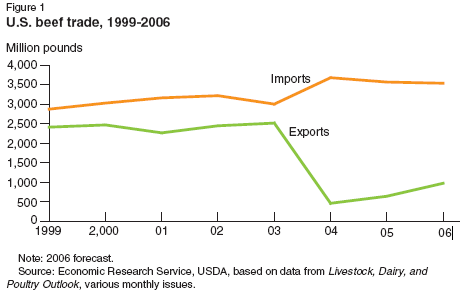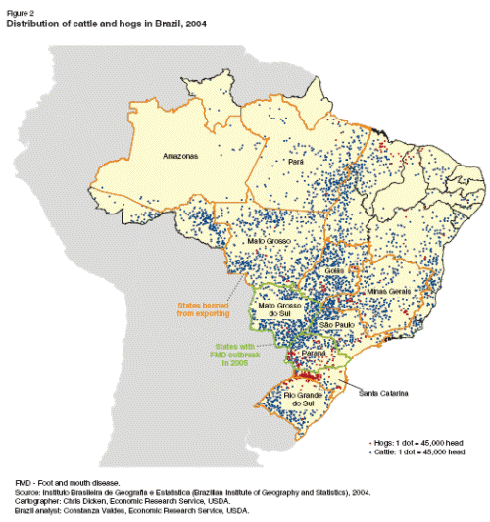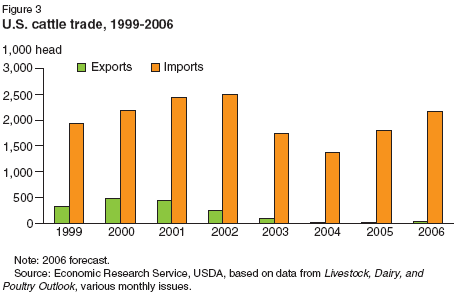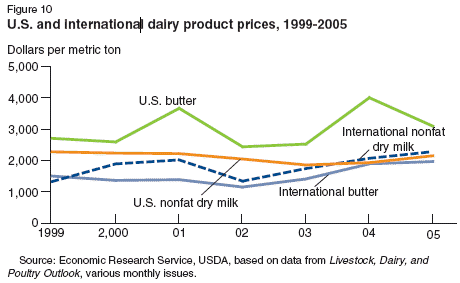



Animal Products Markets in 2005 and Forecast for 2006
By Keithly Jones, Economic Research Service, USDA - Uncertainty continues to shape the forecasts for animal products markets in 2006. Potential and actual animal disease outbreaks, consumer sensitivities, volatile exchange rates, and growing competition from producers in other countries cloud U.S. trade prospects for major meats.
Loss of U.S. trade market share, partly caused by disease outbreaks and related trade restrictions that have affected animal product exports since 2003, compounds the problem. The outlook for U.S. meat, poultry, and dairy markets in 2006 depends on how well domestic production adjusts to changes in input costs, the effect of exchange rates on trade, the continuing effects of disease and trade restrictions on exports, and the increasing competitiveness of emerging animal products exporters.
Introduction
Vulnerability and volatility shape the forecasts for animal product markets and trade in 2006 and beyond. This report examines how potential and recent actual animal disease outbreaks, shaken consumer confidence, volatile exchange rates, and growing competition from producers in other countries affect U.S. trade prospects for major meats.
Animal product producers in Australia, Brazil, and Argentina compete with U.S. producers for export market share, but they, too, face a number of limitations. On the one hand, feed grain constraints limit Australia’s production of fed beef and thus its potential in satisfying the lucrative Japanese beef market. The United States was kept out of the Japanese market for over 2 years because of disease restrictions related to bovine spongiform encephalopathy (BSE, mad cow disease). On the other hand, Brazil and Argentina have ample feed, but exports to Japan are restricted by their own disease-related issues. In addition, Argentina imposed a beef export ban, which, while aimed at controlling domestic prices, excluded Argentine beef from most international markets.
Changes in input costs also create challenges. Corn is one of the primary ingredients in animal feed and often accounts for a significant portion of production costs. With higher energy costs and greater emphasis on ethanol as an alternative fuel, corn prices are forecast to rise significantly in 2006. Although distiller’s grain, a byproduct of ethanol production, is used in animal feeding, it is by no means a perfect substitute, and its use is limited, especially for poultry and hogs.
The outlook for U.S. meat, poultry, and dairy markets in 2006 depends on how well domestic production adjusts to changes in input costs, the effects of exchange rates on imports and exports, the continuing effects of disease and trade restrictions on exports, and the increasing competitiveness of some emerging animal product exporters.
Beef Trade
The United States is both an importer and exporter of beef and live cattle. In 2005, U.S. beef imports totaled 3.6 billion pounds, down 2 percent from the previous year (fig. 1). Cyclically low U.S. cow slaughter and loss of cow imports from Canada have kept processing beef imports at relatively high levels. Favorable exchange rates increased imports from Uruguay, but in 2006, U.S. beef imports are expected to decline almost 11 percent further, due to a weaker U.S. dollar and the increasing domestic cow slaughter replacing imported processing beef.
U.S. beef exports peaked in 2003 just before the discovery of a cow in the State of Washington with BSE. Immediately, thereafter, U.S. beef exports almost disappeared. Although markets are reopening in countries where market access has been regained, beef exports are still far below pre-BSE levels. As a result, formerly exported beef is staying on the domestic market, increasing the overall domestic supply of beef. Exports in 2005 were just over 698 million pounds, up over 50 percent from 2004, and are forecast for another year-over-year increase of 58 percent in 2006.
The 2003 discovery of BSE, as well as subsequent discoveries in 2005 and 2006, continues to hurt U.S. beef trade. Mathews et al. provide a full exposition on the chronology of BSE in North America.1 Beef exports are forecast at just over 1 billion pounds for 2006, nearly 50 percent higher than in 2005, as sales to existing markets have been strong and trade with Japan has now resumed. However, this forecast is significantly less than the 2.5 billion pounds exported in 2003 before the first North American BSE cases. Mexico and Canada are currently the largest markets for U.S. beef.
The reopening of export markets was set back somewhat by discovery of a second case of BSE in the U.S. in 2005, as well as by additional precautions now required by some other importing countries. Taiwan reopened its market to U.S. beef for a short period early in 2005, closed it after the report of the second case of BSE, but reopnend it in February 2006. In December 2005, Japan and several smaller Asian markets were reopened, but beef shipments to Japan were later halted pending completion of an investigation of a problem with a veal shipment. The shipment involved meat products not approved for export to Japan. While the meat shipment met the age requirements, it did not meet Japan’s requirement for removal of bones and specified risk materials. On Thursday, July 26, 2006, Japan agreed to reopen its market to U.S. beef after an investigation of the U.S. inspection program. Under the agreement, the Japanese will accept shipments only of beef from cattle 20 months or younger from a list of 34 approved processing plants. Certification of the plants came following a month-long tour by a Japanese Agriculture Ministry advisory committee of 35 U.S. plants to ensure that they met required safeguards against BSE.
Animal disease and food safety threats have weighed on consumer confidence in many countries.2 Consumers in importing countries often respond to disease outbreaks by reducing demand.3 Even so, consumer confidence can be regained if consumers become convinced that they do not face significant risk.4 Rebuilding consumer confidence, however, is a slow process, and recurring disease outbreaks or marketing high-risk products will lengthen the recovery time. This delay was evident in Japan and is still evident in some other Asian countries where reopening markets to U.S. beef is slowed by reports of the second case of BSE in 2005 and the addition of extra precautions to ensure that what they felt were high-risk products did not reach their shores.
Competition among suppliers shapes animal product trade. Uncertainties, or vulnerabilities, that disrupt the livestock sector in one exporting country create opportunities for competitors. Exchange rate variations can influence beef trade forecasts. In 2005, the U.S. dollar depreciated relative to the currencies of most of its livestock trading partners. Imported products became more expensive to U.S buyers, while U.S. exports to other countries became less expensive. Along with exchange rate variations, which affect the relative prices of imported and exported products, vulnerabilities caused by disease outbreaks, or perceived threats of outbreaks, and the vagaries of weather also affect trade flows.
For example, several countries closed their markets to U.S. beef following announcement of the BSE case in Washington in 2003. To satisfy consumer demands, these countries turned to other beef-exporting countries, such as Australia. While many of the beef products supplied by alternative suppliers are not perfect substitutes for U.S. beef, they are close enough. The longer export markets remain closed to U.S. exports, the greater the difficulty for the United States to regain its earlier market share when they reopen. Market recovery may be slow for the following reasons:
• Consumer habits often forestall re-establishment of past consumption patterns.5
• Many export arrangements are contractual, so when a market reopens, the flow of products from the past supplier is likely to be at a lower level because arrangements from the supplier, the buyer, or both may restrict immediate resumption of trade. In 2004, much of the Japanese import market for beef shifted to Australia.

How much of that market the United States regains upon resumption of trade will depend heavily on Japan’s preference for Australian beef as well as the contractual arrangements forged by the two countries.
• Price competition among exporters may affect consumer decisions, especially if the product is a close substitute.
• Consumer confidence in the safety of U.S. beef will be important. A large public outreach effort may be required to repair damage to the image of U.S. beef.
The October 2005 outbreak of foot-and-mouth disease (FMD) in one of Brazil’s major beef-producing states, Mato Grosso do Sul (MGS), was also noteworthy for global beef trade. Apart from the outbreak’s effect on consumer confidence, it also raised concerns over adjustments required in global meat markets because Brazil is the world’s largest beef and poultry exporter and third-largest pork exporter. Following the FMD announcement, several countries imposed restrictions on imports of Brazilian beef and pork from MGS. Restrictions also affected sales from two neighboring states (fig. 2). MGS shares its western border with Paraguay and is Brazil’s largest cattle-producing state, with over 19.8 million head in 2004 (12 percent of the country’s cattle herd). MGS also accounts for the largest share of cattle slaughter in the country-16 percent, or 5.5 million head. The FMD outbreak, because Brazil’s trade was restricted, created trade opportunities for competitors, such as Australia and Uruguay.

Live Cattle Trade
All live cattle trade, though mostly limited to North America, has been beset by similar issues as those for beef trade. The main concerns for the United States are to protect human and animal health from BSE while providing for the importation of certain animals and commodities from minimal-risk regions. After the May 2003 BSE discovery in Canada, live animal imports from Canada into the United States were banned because Canada was no longer considered a minimal-risk region. A Federal court approved removal of the ban on July 14, 2005; the first cattle since implementation of the ban crossed from Canada into the United States on July 18, 2005. Only fed cattle younger than 30 months crossed the border initially, but feeder cattle followed shortly thereafter. However, monthly volumes were much less than during the pre-BSE period, likely because the ban is still in effect for animals older than 30 months. In 2005, 1.8 million head of live cattle were imported from Canada and Mexico, up 32 percent from 2004; in 2006, live imports are forecast to rise again—over 2.2 million head, up 24 percent from 2005 (fig. 3). A large share of 2005 live imports was lightweight feeder cattle from Mexico.
As U.S. live cattle imports declined during the ban on Canadian imports, so too did live exports to Canada. Live exports dropped to an all-time low of 16,000 head in 2004, increased to 22,000 head in 2005, and are forecast to increase to 40,000 head in 2006. The cause of much of the initial drop was probably that feeder cattle normally sent to Canada to be fed were kept in U.S. feedlots because they could not be re-exported back to the United States as fed cattle.

Dairy Trade
Dairy product trade is largely influenced by exchange rate variability and competing supplies worldwide. The U.S. dollar was weak in 2005, but global supplies of dairy products remained generally tight. Lower production of nonfat dry milk in New Zealand, Australia, and the EU limited international market supplies. In 2005, international prices for nonfat dry milk averaged about $2,000 per ton, 10-15 percent above those of 2004 (fig. 10). The strong export demand, coupled with international powder prices’ exceeding 2004 levels, enabled the U.S. to expand exports of commercial nonfat dry milk powder. Tight supplies and strong demand also pushed international 2005 butter prices above 2004 levels. However, lower U.S. butter and cheese prices largely eliminated the incentive to ship over-quota levels of dairy products to the United States. Total U.S. imports of dairy products fell by more than one-half during 2005, primarily reflecting a virtual halt in over-quota imports of butter (down 97 percent) and a sharp decline in imports of American-type cheese (down 75 percent).
Although good global economic growth is expected to help maintain international demand for butter and nonfat dry milk powders in 2006, competition from other trading partners may remain limited by tight supplies. Milk production in Australia is forecast to decrease slightly during its 2006 marketing year, while New Zealand production likely will increase by about 4 percent. Milk production in the EU, constrained by quotas, is expected to grow less than 1 percent. As global demand for dairy products continues to remain firm, international prices in 2006 are expected to stay at or near last year’s levels. U.S. prices are expected to remain fairly competitive, and exports are expected to remain strong. Increased world supply of nonfat dry milk powders is likely to result in reduced global export demand, lower export levels of U.S. products, and some weakening of prices.

Uncertainty Abounds in Meat Trade Outlook
Potential and actual animal disease outbreaks, consumer sensitivities, volatile exchange rates, and growing competition from producers in other countries cloud U.S. trade prospects for major meats in 2006. The entire meat animal complex has the potential to be affected, directly or indirectly, by disease-related uncertainty. Pork appears to be a temporary beneficiary of the uncertainty among trade of other major animal products, and, as a result, expanded pork trade is expected.
The outlook for U.S. meat, poultry, and dairy markets in 2006 depends on the how well domestic production adjusts to changes in input costs, the effects of exchange rates on trade, the continuing effects of disease and trade restrictions on exports, and the increasing competitiveness of some of the emerging suppliers of animal products. Brazil and Australia have emerged as significant competitors to the United States in some animal products, but disease concerns in Brazil and resource limitations in Australia slow their ability to significantly erode the U.S. share of animal product trade.


